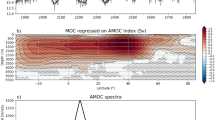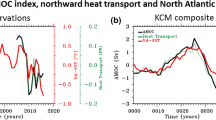Abstract
The transient climate response to a collapse of the Atlantic meridional overturning circulation (AMOC) is analysed from the difference between two ensembles of climate model simulations with ECHAM5/MPI-OM, one with hosing and the other without hosing. The primary effect of the collapse is to redistribute heat over the two hemispheres. However, Northern Hemisphere sea ice increase in response to the AMOC collapse induces a hemisphere-wide cooling, amplified by atmospheric feedbacks, in particular water vapour. The Southern Hemisphere warming is governed by slower processes. After 25 years the global cooling peaks. Thereafter, the response is characterised by a gradual readjustment of global mean temperature. During the AMOC collapse a downward radiation anomaly arises at the top of the atmosphere (TOA), heating the earth’s surface. The net downward radiation anomaly at TOA arises from reduced longwave emission by the atmosphere, overcompensating the increased net upward anomalies in shortwave and longwave radiation at the surface. This radiation anomaly is associated with net ocean heat uptake: cooling of the overlying atmosphere results from reduced ocean heat release through the increase of sea-ice cover in the North Atlantic. The change in energy flow arises from the reduction in latent and sensible heat flux, which dominate the surface radiation budget. Similar experiments with a climate model of intermediate complexity reveal a stronger shortwave response that acts to reduce the net downward radiation anomaly at TOA. The net shortwave and longwave radiation anomalies at TOA always decrease during the first 100 years after the AMOC collapse, but in the intermediate complexity model this is associated with a sign change after 90 years when the net radiation anomaly at TOA becomes upward, accompanied by net ocean heat loss. After several hundred years the longwave and shortwave anomalies increase again, while the net residual at TOA remains small. This radiative adjustment is associated with the transition to a colder climate.







Similar content being viewed by others
References
Alley RB et al (2003) Abrupt climate change. Science 299:2005–2010
Ahn J, Brook EJ (2008) Atmospheric CO2 and climate on millennial time scales during the last glacial period. Science 322:83–85
Bjerknes J (1964) Atlantic air-sea interaction. Adv Geophys 10:1–82
Blunier T, Brook EJ (2001) Timing of millennial-scale climate change in Antarctica and Greenland during the last glacial period. Science 291:109–112
Broecker WS (1998) Paleocean circulation during the last deglaciation: a bipolar seesaw? Paleoceanography 13:119–121
Cheng W, Bitz CM, Chiang JCH (2007) Adjustment of the global climate to an abrupt slowdown of the Atlantic meridional overturning circulation. Ocean Circ Mech Impacts Geophys Monogr Ser 173:295–313
Chiang JCH, Bitz CM (2005) Influence of high latitude ice cover on the marine intertropical convergence zone. Clim Dyn 25:477–496
Cimatoribus AA, Drijfhout SS, Dijkstra HA (2012a) A global hybrid coupled model based on Atmosphere-SST feedbacks. Clim Dyn 38:745–760
Cimatoribus AA, Drijfhout SS, den Toom M, Dijkstra HA (2012b) Sensitivity of the Atlantic meridional overturning circulation to South Atlantic freshwater anomalies. Clim Dyn 39:2291–2306
Cvijanovic I, Chiang JCH (2013) Global energy budget changes to high latitude North Atlantic cooling and the tropical ITCZ response. Clim Dyn 40:1435–1452
Drijfhout SS (2010) The atmospheric response to a THC collapse: Scaling relations for the Hadley circulation and the nonlinear response in a coupled climate model. J Clim 23:757–774
Drijfhout SS, de Vries P, Döös K, Coward AC (2003) Impact of eddy-induced transport on the Lagrangian structure of the upper branch of the thermohaline circulation. J Phys Oceanogr 33:2141–2155
Drijfhout SS, Weber SL, van der Swaluw E (2011) The stability of the MOC as diagnosed from model projections for pre-industrial, present and future climates. Clim Dyn 37:1575–1586
Ganachaud A, Wunsch C (2003) Large-scale ocean heat and freshwater transports during the World Ocean Circulation Experiment. J Clim 16:696–705
Hansen J et al (2008) Target atmospheric CO2: where should humanity aim? The Open Atmos Sci J 2:213–217
Jackson LC (2013) Shutdown and recovery of the AMOC in a coupled global climate model: the role of the advective feedback. Geophys Res Lett 40:1182–1188
Laurian A, Drijfhout SS, Hazeleger W, van Dorland R (2009) Global surface cooling: the atmospheric fast feedback response to a collapse of the thermohaline circulation. Geophys Res Lett. doi:10.1029/2009GL040938
Laurian A, Drijfhout SS, Hazeleger W, van den Hurk B (2010) Response of the Western European climate to a collapse of the thermohaline circulation. Clim Dyn 34:689–697
Laurian A, Drijfhout SS (2011) Response of the South Atlantic circulation to an abrupt collapse of the Atlantic meridional overturning circulation. Clim Dyn 37:521–530
Liu Y, Chiang JCH, Chou C, Patricola CM (2014) Atmospheric teleconnection mechanisms of extratropical North Atlantic SST influence on Sahel rainfall. Clim Dyn. doi:10.1007/s00382-014-2094-8
Marsland SJ, Haak H, Jungclaus JH, Latif M, Röske F (2003) The Max-Planck-Institute global ocean/sea ice model with orthogonal curvilinear coordinates. Ocean Modell 5:91–127
Roeckner E et al. (2003) The atmospheric general circulation model ECHAM 5. Part I: Model description. Max-Planck-Institute Report 349, 127 pp
Severijns CA, Hazeleger W (2009) The efficient global primitive equation climate model SPEEDO. Geosci Model Dev Discuss 2:11–15
Stocker TF, Johnsen SF (2003) A minimum thermodynamic model for the bipolar seesaw. Paleoceanography. doi:10.1029/2003/PA000920
Stouffer RJ et al (2006) Investigating the causes of the response of the thermohaline circulation to past and future climate changes. J Clim 19:1365–1387
Trenberth KE, Fasullo JT, Kiehl J (2009) Earth’s global energy budget. Bull Am Meteorol Soc 90:311–324
Vellinga M, Wood RA (2002) Global climatic impacts of a collapse of the Atlantic thermohaline circulation. Clim Change 54:251–267
Vellinga M, Wu P (2008) Relations between northward ocean and atmosphere energy transports in a coupled climate model. J Clim 21:561–575
Weber SL, Drijfhout SS (2007) Stability of the Atlantic meridional overturning circulation in the Last Glacial Maximum climate. Geophys Res Lett. 34 doi:10.1029/2007GL031437
Winton M (1995) Why is the deep sinking narrow? J Phys Oceanogr 25:997–1005
Xie S-P, Philander SGH (1994) A coupled ocean-atmosphere model of relevance to the ITCZ in the eastern Pacific. Tellus 46A:340–350
Zhang R, Delworth TL (2005) Simulated tropical response to a substantial weakening of the Atlantic thermohaline circulation. J Clim 18:1853–1860
Zhang R, Kang SM, Held IM (2010) Sensitivity of climate change induced by the weakening of the Atlantic meridional overturning circulation to cloud feedback. J Clim 23:378–389
Acknowledgments
The ESSENCE project, lead by Wilco Hazeleger and Henk Dijkstra, was carried out with support of DEISA, HLRS, SARA, and NCF (through NCF Projects NRG-2006.06, CAVE-60-023 and SG-06-267). The DEISA Consortium (co-funded by the EU FP6 Project 508830/031513) is thanked for support within the DEISA Extreme Computing Initiative. The author thanks Geert-Jan van Oldenborgh for suggestions and comments, Camiel Severijns for modelling support and two anonymous reviewers for their constructive criticism on an earlier version of the paper.
Author information
Authors and Affiliations
Corresponding author
Rights and permissions
About this article
Cite this article
Drijfhout, S.S. Global radiative adjustment after a collapse of the Atlantic meridional overturning circulation. Clim Dyn 45, 1789–1799 (2015). https://doi.org/10.1007/s00382-014-2433-9
Received:
Accepted:
Published:
Issue Date:
DOI: https://doi.org/10.1007/s00382-014-2433-9




